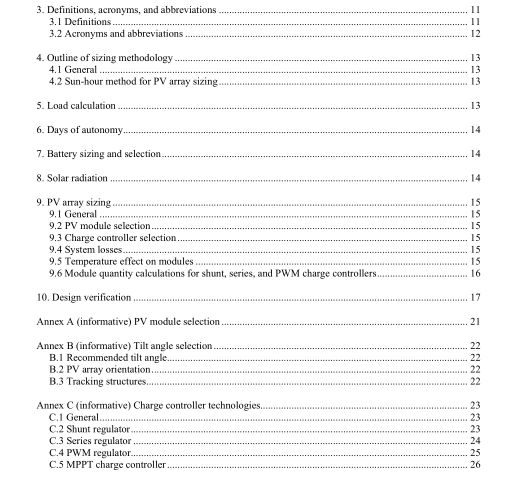IEEE 1562-2021 pdf download.IEEE Recommended Practice for Sizing of Stand-Alone Photovoltaic (PV) Systems
This recommended practice provides a procedure to size a stand-alone photovoltaic (PV) system. Systems considered in this document consist of PV as the only power source and a battery for energy storage. These systems also commonly employ controls to protect the battery from being over- or undercharged and may employ a power conversion subsystem (inverter or converter). The issues of array utilization, battery-charge efficiency, and system losses are also considered in terms of their effect on system sizing. This recommended practice is applicable to all stand-alone PV systems where PV is the only charging source. This document does not include PV hybrid 2 systems or grid-connected systems. This document is normally intended to be used in conjunction with IEEE Std 1013 when the solar/PV array is paired with a lead-acid battery systems. 3 This recommended practice does not include the sizing of the system controller, inverter, wiring, or other system components.
1.2 Purpose The purpose of this recommended practice is to provide procedures to size the PV system according to accepted methods, to improve the performance, cost-effectiveness, and lifetimes of stand-alone PV systems. These procedures are intended to assist designers, manufacturers, system integrators, users, and laboratories with information necessary for sizing, modeling, and evaluating the performance of stand-alone V systems.
1.3 Word usage The word shall indicates mandatory requirements strictly to be followed in order to conform o the standard and from which no deviation is permitted (shall equals is required to).
The word should indicates that among several possibilities one is recommended as particularly suitable,without mentioning or excluding others; or that a certain course of action is preferred but not necessarily required (should equals is recommended that).
The word may is used to indicate a course of action permissible within the limits of the standard (may equals is permitted to).
The word can is used for statements of possibility and capability, whether material, physical, or causal (can equals is able to).
2. Normative references
The following referenced documents are indispensable for the application of this document (i.e., they must be understood and used, so each referenced document is cited in text and its relationship to this document is explained). For dated references, only the edition cited applies. For undated references, the latest edition of the referenced document (including any amendments or corrigenda) applies.
IEEE Std 1013™, IEEE Recommended Practice for Sizing Lead-Acid Batteries for Stand-Alone Photovoltaic (PV) Systems. 6,7
IEEE Std 1361™, IEEE Guide for Selection, Charging, Test and Evaluation of Lead-Acid Batteries Used in Stand-Alone Photovoltaic (PV) Systems.
3. Definitions, acronyms, and abbreviations
3.1 Definitions
For the purposes of this document, the following terms and definitions apply. The IEEE Standards Dictionary Online should be consulted for terms not defined in this clause. 8
array-to-load ratio (A:L): The average daily photovoltaic ampere-hours (Ah) available to charge the battery divided by the average daily load in ampere hours.
NOTE—The average daily PV ampere hours is calculated by taking the average sun-hours for the month of nterest times
the array current at its maximum power point (I mp ) under standard test conditions (STC).
autonomy: The length of time that a photovoltaic (PV) system can provide energy to the load without receiving energy from the PV array.
charge controller: An electrical control device that regulates battery charging by voltage control and/or other means.
loss-of-load probability (LOLP): The probability (typically expressed as a percent) of the photovoltaic (PV) power system to have insufficient energy to support the load due to lack of solar radiation.
plane of array (POA): A plane that is at the same tilt angle and azimuth as the photovoltaic (PV) array.
solar irradiance: The instantaneous power density of sunlight measured in watts per meter squared (W/m 2 ).
solar radiation: The time integral of solar irradiance.IEEE 1562 pdf download.IEEE 1562-2021 pdf download
IEEE 1562-2021 pdf download

Leave a Reply